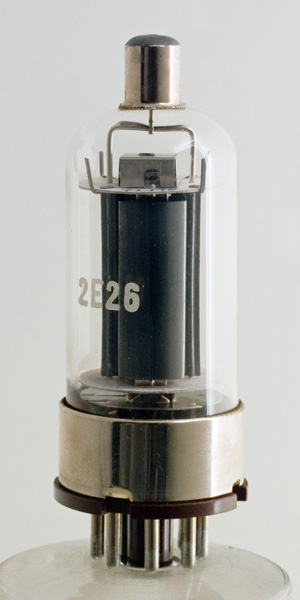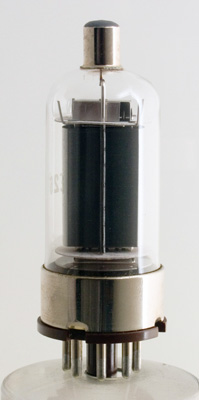|
2E26Sensibly equivalent¶ to:CV3990See also:
|
|
|

|
The 2E26 is a small VHF transmitting beam tetrode that was typically used in mobile transmitters. As a single ended Class C RF amplifier it would generate up to 13.5 Watts in the VHF range to 125 MHz. If used in push-pull with up to 500 volts on the anodes the pair could produce up to 50 Watts but 27 would be more typical. The maximum dissipations of 10 Watts anode and 2.5 Watts for the screen had to be observed and so it is probably that they would have been used for telephony rather than CW.In class A1 as an audio amplifier the output could approach 5.3 Watts at 10% THD according to the data sheet. However the maximum anode dissipation is 10 Watts and typical efficiencies would tend to 30%.As with other transmitting valves the design allowed them to be used as AF modulators as well. For AM modulation the 2E26 would be used as either class AB1 push-pull or single ended for low powers. With this dual use the transmitter would need fewer valve types as spares. This was particularly required in mobile communications.
The box anode is surmounted by the top mica. Above the mica the grid cooling fins can be seen.The wide glass tube envelope is 28 mm in diameter, and excluding the IO base pins is 76 mm tall.References: Data-sheet & 4038. Type 2E26 was first introduced in 1947. See also 1947 adverts. |
Pin Connections
| 1 | 2 | 3 | 4 | 5 | 6 | 7 | 8 | tc |  k,g3,s | h | g2 | k,g3,s | g1 | k,g3,s | h | m | a |
|
|
Absolute Maximum Operating Conditions¶
| Vh | Ah | Va | Vs | Vg | mAa | mAs | 
| 6.3 | 0.8 | 300 | 200 | -14 | 66 | 7.0 |
|
Updated October 03, 2022.
|
|